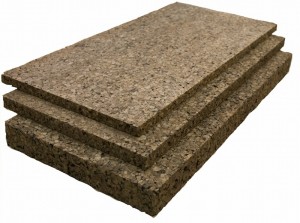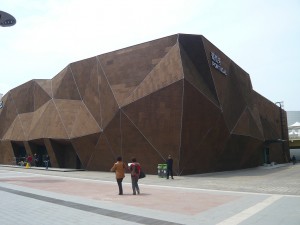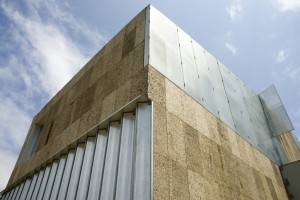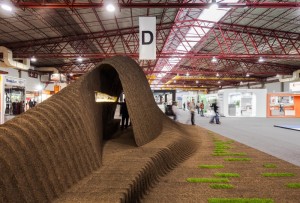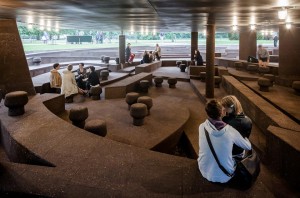IMAGE: Jetson Green – www.jetsongreen.com
Hello, we are the cork Team (19 – organic). Matteo Silverio + Ran Shabtay
SCIENTIFIC NAME: QUERCUS SUBER
FORMULA /CHEMICAL COMPOSITION:
C123H182O56N
Ash 0.7%. total extractives 15.3%, Suberin 38.6%, Lignin 21.7% and polysaccharides 18.2%. The carbohydrate composition shows that glucose represents 50.6% of all monosaccharides, Xylose 35%, arabinose 7.0% and galactose and mannose respectively 3.6% and 3.4%.
MATERIAL DESCRIPTION:
Cork consists of the irregularly shaped, thin-walled, wax-coated cells that make up the peeling bark of many trees. Cork is unique because it is made of air-filled, watertight cells that are a remarkably effective insulating medium. The air pockets make cork very light in weight.
EXTRACTION PROCESS:
Cork material is harvested from the cork oak tree (Quercus Suber), but instead of needing to cut down the tree to source the benefit of the raw material as is done with the majority of all other wood species, the bark (or outer skin) of the tree is peeled off, and the tree is left to regenerate. For this reason, cork industry is regarded as environmentally friendly and sustainable.
BASIC PROPERTIES:
COMPRESSIVE STRENGH (kN/m2) 86,30 (A)
TENSILE STRENGH (kN/m2) 294,20 (A)
STIFFNESS (kN/m2) 335,39 (A)
DENSITY (Kg/m3) 150-160 (B)
CARBON FOOTPRINT COVERAGE (KgCO2/Kg) 0,19 (C)
3D PRINTING -
MILLING YES
BASIC PROPRIETIES SOFT, FLEXIBLE,WARM
LASER YES
RECYCABLE YES
NOTE:
A: CorkPanel BetonWood, material data sheet. More info: www.betonwood.com
B: Variable density according to the fabrication process
C: Geoff Hammond, Craig Jones – INVENTORY OF CARBON&ENERGY (ICE) VERSION 1.6a www.uea.ac.uk/~e680/energy/NBS-M016/ICE%20Version%201.6a.pdf
ADVANTAGE IN THE CONTEXT OF DIGITAL FABRICATION:
Cork is totally natural, 100% recyclable and available in many formats and thickness. Moreover, it’s impermeable to liquids, elastic, resilient, it possess acoustic insolation and it’s resistant to chemical and microbial attacks.
MATERIAL SUPPLIERS:
BCK barnacork – Carrer C/ Llull, 47-49 planta 4 local 5 T: 93 309 77 83 web: www.barnacork.com
Servicio Estación – Carrer d’Aragó, 270-272 T: 93 381 28 91 web: www.serveiestacio.com
Surotecnica – Carrer Muntaner, 56 T: 93 453 47 11 web: www.surotecnica.com
PRICE (915x610mm – thickness: 1, 1.5, 2, 3, 4, 5, 6, 7, 8, 10, 12, 15, 20, 25, 30, 40, 50, 100)
BCK barnacork: 100 mm = 118,36 € CHEAPEST: ~8,51 €/Kg
BIBLIOGRAPHY
WEB:
www.sustainablematerials.com/cork/
www.materialproject.org/wiki/Cork
www.sciencedaily.com/releases/2012/06/120622162946.htm
www.sciencedaily.com/releases/2014/04/140416113012.htm
www.nature.com/srep/2012/120509/srep00403/full/srep00403.html
www.apcor.pt/artigo/cork-production.htm
BOOKS:
Helena Pereira, Cork: Biology, Production and Uses Hardbound 2007 – ISBN: 978-0-444-52967-1
PROJECT REFERENCE PHOTOS WITH INFOS AND LINKS
The Portugal Pavilion in EXPO Shanghai 2010
Designer: Arch. Carlos Couto
Date: 2010
Location: Shanghai
web: www.amorim.com/en/how-we-do-it/reference-projects/Portuguese-Pavilion-Expo/440/
Description:
Built with 5500 m2 of cork supplied by Corticeira Amorim, the Portuguese Pavilion at Expo 2010 Shanghai
was a surprise for its originality. The design was developed in harmony with the Better City, Better Life
concept, by using cork as the solution for an environment-friendly construction in the future.
Cork House
Designer: Arquitectos Anonimos and Paulo Teodósio
Date: 2007
Location: Esposende, Portugal
web: www.bjoku.com/cork-house-by-arquitectos-anonimos/
Description:
The shaped carcass, stoutly wrapped with cork bricks, deals a few radical ruptures, claiming a friendly
distance to the neighborhood. Inside, the expectable “ready to inhabit” combines a straight preview to the
changeable future and conditions, as direct as possible-translated in interior design.
Cork Pavilion
Date: 2013
Location: Portugal
web: www.inhabitat.com/portuguese-students-build-gorgeous-vaulted-pavilion-entirely-from-cork/
Description:
Students of the Advanced Program in Digital Architecture (CEAAD) in Portugal teamed up with the company
AMORIM Isolamentos to create a beautiful pavilion entirely from cork. The Vaulted Cork Pavilion was
parametrically designed, assembled out of hundreds of CNC-cut blocks, and then installed at the Concreta
2013 building expo in Porto.
The 2012 Serpentine Pavilion
Designer: Herzog & de Meuron and Ai Weiwei
Date: 2012
Location: London
web: www.dezeen.com/2012/05/08/serpentine-gallery-pavilion-2012-by-herzog-de-meuron-and-ai-weiwei/
Description:
Eleven columns characterising each past Pavilion, and a twelfth column representing the current structure,
support a floating platform roof 1,4 metres above ground. The Pavilion’s interior is clad in cork, a sustainable
building material chosen for its unique qualities and to echo the excavated earth.
Chaise Lounge Chair
Designer: DMFD Studio
Date: 2012
Location: USA
web: www.danielmichalik.com/
Description:
the sustainable lounge chair has a curved design mimicking a wave. The design is freestanding and balanced
on the curve of its base. As the material is lightweight, the chair is both stable and bouyant, and can be
rocked gently from side to side.

